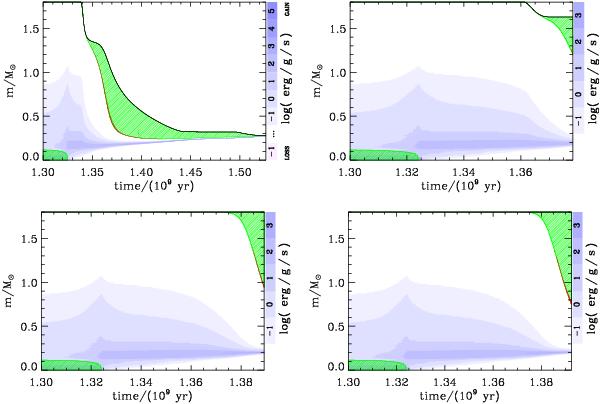Fig. 6

Kippenhahn diagram of four 1.8 M⊙ donor stars undergoing early Case B RLO in X-ray binaries with an accreting WD and orbital periods of 1.5, 2.0, 2.5, and 2.8 days, respectively. The plots show cross-sections of the stars in mass-coordinates from the centre to the surface of the star, along the y-axis, as a function of stellar age on the x-axis. The green hatched areas denote zones with convection (according to the Ledoux criterion) initially in the core and later in the envelope of the donor stars. The intensity of the blue/purple color indicates the net energy-production rate; the hydrogen burning shell is clearly seen in all panels at m/ M⊙ ≃ 0.2. In the top-left panel, the donor star decreases its mass from 1.8 M⊙ until it finally detaches from the Roche lobe and forms a 0.28 M⊙ He WD. In the top-right panel, our calculation stops when the donor star reached 1.62 M⊙ since the mass-transfer rate became too high when the donor star refilled its Roche lobe, following an initial phase of stable RLO with a lower value of |Ṁ2|. In the two lower panels the mass-transfer rate went immediately up to the critical value at the onset of the RLO. The response of a donor star to mass loss depends strongly on the depth of its convective envelope and thus, as seen here, it depends on Porb. See Fig. 4 and text for a discussion.
Current usage metrics show cumulative count of Article Views (full-text article views including HTML views, PDF and ePub downloads, according to the available data) and Abstracts Views on Vision4Press platform.
Data correspond to usage on the plateform after 2015. The current usage metrics is available 48-96 hours after online publication and is updated daily on week days.
Initial download of the metrics may take a while.






